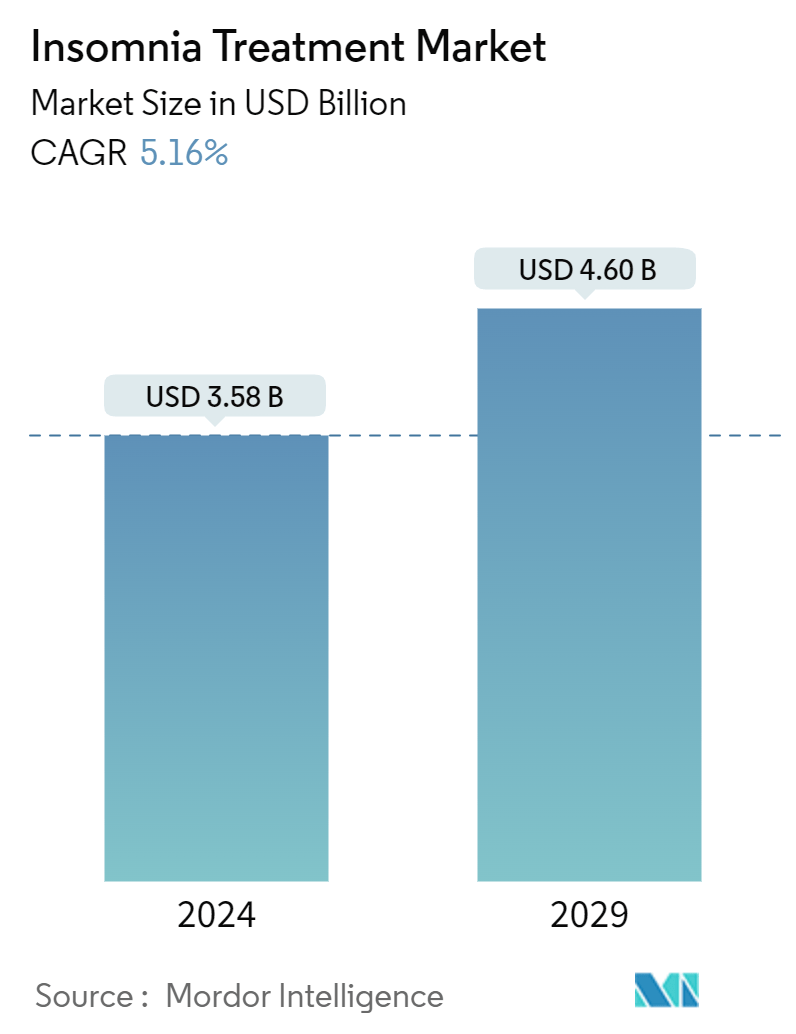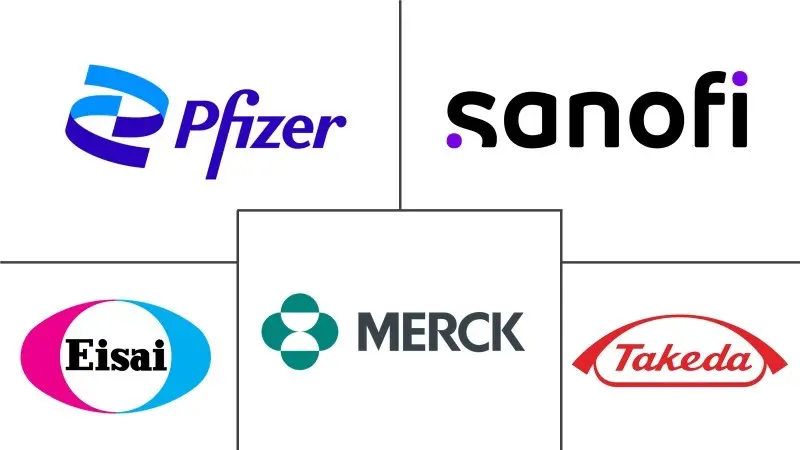Market Size of Insomnia Treatment Industry

| Study Period | 2019 - 2029 |
| Market Size (2024) | USD 3.58 Billion |
| Market Size (2029) | USD 4.60 Billion |
| CAGR (2024 - 2029) | 5.16 % |
| Fastest Growing Market | Asia-Pacific |
| Largest Market | North America |
| Market Concentration | Low |
Major Players
*Disclaimer: Major Players sorted in no particular order |
Insomnia Treatment Market Analysis
The Insomnia Treatment Market size is estimated at USD 3.58 billion in 2024, and is expected to reach USD 4.60 billion by 2029, growing at a CAGR of 5.16% during the forecast period (2024-2029).
Insomnia occurs when individuals face disturbances in their feelings or abilities due to inadequate or poor-quality sleep. Approximately 10% of the global population have insomnia severe enough to be considered a medical issue. While insomnia is typically not life-threatening, there are numerous treatment options available, such as medications and mental health interventions, to address it.
Based on the Sleep Prioritization Survey 2023 conducted by the American Academy of Sleep Medicine (AASM), it was found that approximately 29% of individuals utilize melatonin either occasionally or regularly. The 2022 survey revealed that 64% of Americans relied on some form of substance occasionally or regularly to aid in falling asleep or staying asleep. Of this percentage, 23% use prescription medication, 27% use melatonin, and 20% use marijuana or CBD. The significant impact on individuals' sleep patterns has resulted in an increased demand for insomnia treatment during the pandemic. Despite this, the necessity for insomnia treatment is anticipated to persist even post-pandemic, thereby contributing to the market's growth in the next five years.
The market is projected to experience growth due to the increasing prevalence of insomnia, rising stress levels, and the growing awareness of various treatment options for this condition. As an illustration, the Sleep Foundation 2023 reported that insomnia is a sleep disorder that affects up to 35% of adults. It is defined by difficulties in falling asleep, staying awake during the night, and achieving the desired duration of sleep until the morning. This disorder can lead to significant consequences, including excessive daytime sleepiness, an elevated risk of car accidents, and widespread health issues resulting from sleep deprivation.
The rising stress levels among the global population are another primary driver for the market's growth. According to the Health and Safety Executive report published in 2023, the number of workers reporting work-related stress, depression, or anxiety in the United Kingdom was approximately 875,000. Such high stress among the population is also expected to drive the market's growth. Insomnia rarely occurs on its own and is frequently associated with other illnesses.
Furthermore, innovative product developments for the treatment of insomnia are also expected to contribute to the market's growth. For instance, in June 2022, Pear Therapeutics reported interim follow-up real-world data from a decentralized trail that showed treatment with Somryst, one of the FDA-authorised digital therapeutics for treating chronic insomnia. This device significantly reduced symptoms of insomnia, anxiety, and depression severity.
Thus, factors such as the prevalence of insomnia, rising awareness for treatment, and increasing product launches are expected to contribute to the market's growth during the forecast period. However, misconceptions about the seriousness of insomnia and patients' non-adherence to the treatment are some factors that may limit market growth during the forecast period.
Insomnia Treatment Industry Segmentation
As per the scope of the report, insomnia is a sleep disorder with one or more symptoms that could include fatigue, inability to focus or concentrate, poor memory, mood disturbance, daytime sleepiness, and low motivation or energy. The insomnia treatment market is segmented by treatment type, distribution channel, and geography. Based on the treatment type, the market is segmented into drugs and devices. By distribution channel, the market is segmented into hospital pharmacies, retail pharmacies, and other distribution channels. Geographically, the market is segmented into North America, Europe, Asia-Pacific, Middle East and Africa, and South America. The report offers the value (USD) for the above segments.
| By Treatment Type | ||||||
| ||||||
| Devices |
| By Distribution Channel | |
| Hospital Pharmacies | |
| Retail Pharmacies | |
| Other Distribution Channels |
| By Geography | ||||||||
| ||||||||
| ||||||||
| ||||||||
| ||||||||
|
Insomnia Treatment Market Size Summary
The insomnia treatment market is poised for significant growth over the forecast period, driven by the increasing prevalence of insomnia and rising stress levels globally. Insomnia, characterized by difficulties in falling asleep, staying asleep, and achieving restful sleep, affects a substantial portion of the adult population and is often linked to other health issues. The market is experiencing a surge in demand for various treatment options, including medications and mental health interventions, as awareness of insomnia's impact on health and daily functioning grows. Innovative product developments, such as digital therapeutics and orexin receptor antagonists, are also contributing to market expansion. These advancements offer new avenues for treatment, addressing the limitations of traditional options and enhancing patient adherence.
North America is expected to hold a significant share of the insomnia treatment market, driven by the high prevalence of sleep disorders and supportive government initiatives. The United States and Canada are witnessing increased demand for effective sleep disorder treatments, supported by funding for research and development in this area. The economic burden of inadequate sleep further underscores the need for effective insomnia treatments, prompting both public and private sector investments. The market's fragmented nature, with numerous manufacturers and ongoing product launches, indicates a competitive landscape where major players are actively seeking to expand their offerings and capture market share.
Insomnia Treatment Market Size - Table of Contents
-
1. MARKET DYNAMICS
-
1.1 Market Overview
-
1.2 Market Drivers
-
1.2.1 Increasing Stress Due to Highly Active Lifestyles of Individuals
-
1.2.2 Side Effects Due to Certain OTC and Prescription Medication
-
1.2.3 High Usage of Media Devices Before Sleep
-
-
1.3 Market Restraints
-
1.3.1 Misconceptions about the Seriousness of Insomnia
-
1.3.2 Patient Non-adherence due to Characteristic Side Effects of Insomnia Drugs
-
-
1.4 Porter's Five Forces Analysis
-
1.4.1 Threat of New Entrants
-
1.4.2 Bargaining Power of Buyers/Consumers
-
1.4.3 Bargaining Power of Suppliers
-
1.4.4 Threat of Substitute Products
-
1.4.5 Intensity of Competitive Rivalry
-
-
-
2. MARKET SEGMENTATION (Market Size by Value - USD)
-
2.1 By Treatment Type
-
2.1.1 By Drug
-
2.1.1.1 Benzodiazepines
-
2.1.1.2 Nonbenzodiazepines
-
2.1.1.3 Orexin Antagonist
-
2.1.1.4 Other Drugs
-
-
2.1.2 Devices
-
-
2.2 By Distribution Channel
-
2.2.1 Hospital Pharmacies
-
2.2.2 Retail Pharmacies
-
2.2.3 Other Distribution Channels
-
-
2.3 By Geography
-
2.3.1 North America
-
2.3.1.1 United States
-
2.3.1.2 Canada
-
2.3.1.3 Mexico
-
-
2.3.2 Europe
-
2.3.2.1 Germany
-
2.3.2.2 United Kingdom
-
2.3.2.3 France
-
2.3.2.4 Italy
-
2.3.2.5 Spain
-
2.3.2.6 Rest of Europe
-
-
2.3.3 Asia-Pacific
-
2.3.3.1 China
-
2.3.3.2 Japan
-
2.3.3.3 India
-
2.3.3.4 Australia
-
2.3.3.5 South Korea
-
2.3.3.6 Rest of Asia-Pacific
-
-
2.3.4 Middle East and Africa
-
2.3.4.1 GCC
-
2.3.4.2 South Africa
-
2.3.4.3 Rest of Middle East and Africa
-
-
2.3.5 South America
-
2.3.5.1 Brazil
-
2.3.5.2 Argentina
-
2.3.5.3 Rest of South America
-
-
-
Insomnia Treatment Market Size FAQs
How big is the Insomnia Treatment Market?
The Insomnia Treatment Market size is expected to reach USD 3.58 billion in 2024 and grow at a CAGR of 5.16% to reach USD 4.60 billion by 2029.
What is the current Insomnia Treatment Market size?
In 2024, the Insomnia Treatment Market size is expected to reach USD 3.58 billion.

